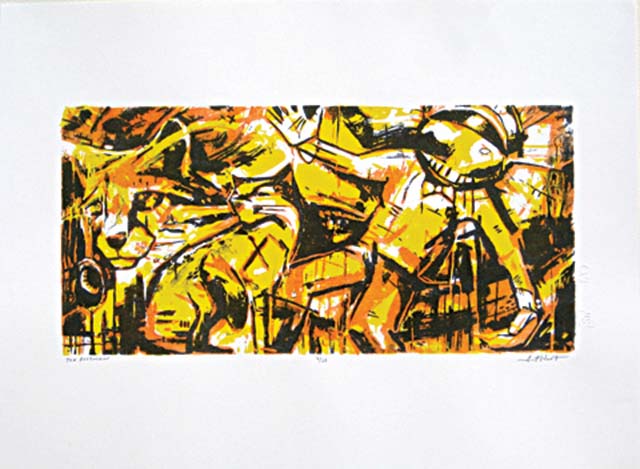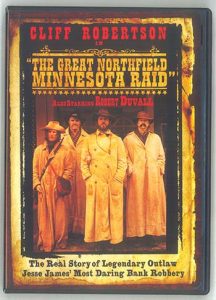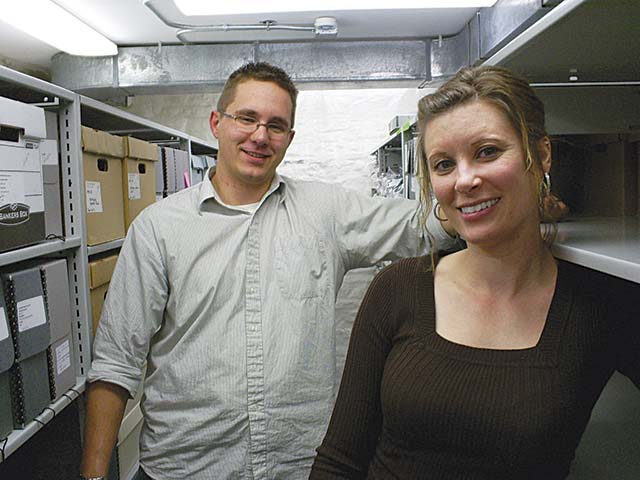
Next month I will have written 75 “Historic Happenings” for the Entertainment Guide, since February of 2007. So it seems appropriate to honor some of our local historical societies that preserve history for us and to tell a few of their stories. This month, a triple play: the historical societies of Northfield, Cannon Falls and Dundas.
Historical artifacts will never be considered “old hat” by the folks at the Northfield Historical Society (“trite from having long been used or known”). But it was an actual old hat that Hayes Scriven, Executive Director of the Northfield Historical Society, and Cathy Osterman, NHS curator, wanted to show me when I visited the archives in February. And the hat had nothing to do with the botched bank robbery attempt of the James-Younger Gang in 1876, which brought fame (and tourists) to Northfield. This hat resurfaced in the course of taking inventory at NHS.
In 1983, Wilbur L. McCandless of Pico Rivera, California, donated artifacts which had belonged to his grandfather, James A. Little, a long-time resident of Northfield. Among the artifacts McCandless described in his accompanying letter were a “bullet torn hat he was wearing when severely wounded in Civil War with brass band giving date of wound,” membership badge in post 83 J.L. Heywood Post Grand Army of the Republic and lapel button, a letter from Little to his grandson Wilbur in 1928 describing his experiences in the Civil War and other information including a copy of Little’s service record in History of the 112th Regiment of the Illinois Volunteer Infantry in the Great War of the Rebellion, 1862-1865, printed in 1885. According to the book excerpt, Little enlisted on March 28 and was mustered on April 25, 1864, for three years. “Severely wounded in action at Utoy Creek, near Atlanta, Ga., Aug. 6, ’64. Appointed Sergeant of Co. F., 65th Ill.” His address at that time was given as Hastings, Dakota County, Minnesota.
McCandless explained in the letter that his grandfather was uncle to Ruth (Little) Hutton of Farmington and great-uncle and great-great uncle to “my many cousins in the Northfield area,” which was his reason for wanting the items to be in Northfield. Curator Osterman says McCandless appears to have sent the objects in April of 1983 in time for a Civil War display.
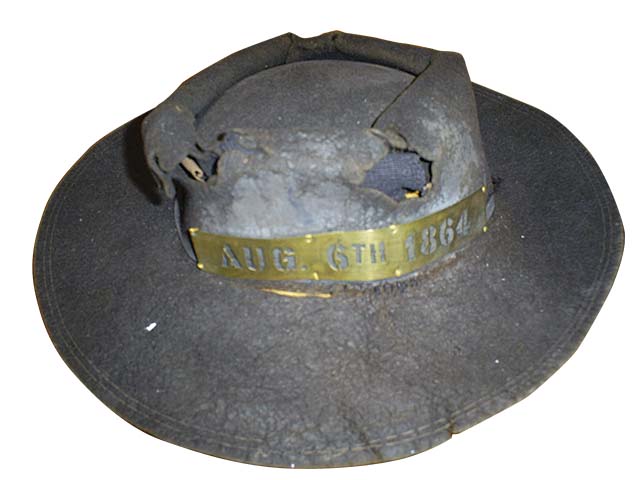
Little’s Civil War hat, torn through with ragged bullet holes, bears mute but eloquent testimony to the horrors of war. Little’s letter to his grandson Wilbur, age 13, fills in details. Wilbur had asked his grandfather to write down some of his army experiences and on Oct. 10, 1928, from a Soldier’s Home in California, Little complied, saying he would tell of one day’s experience of Aug. 6, 1864.
Little said that he rose early, wrote to his wife saying they would probably be in the battle before night and “sat down to put some eyelets in my hat and we were called into line immediately and the thought came to me that perhaps the Johnies would ventilate it before night.” (“Johnnies” were names for the Confederate rebels and “ventilation” referred to bullet holes.) Little wrote that about 15 minutes later “a small cannon ball struck a high stump of a tree and into our company it came injuring the right leg of the man on my left and hit the man on my right, the bottom of his shoe and turning his foot black in one minute…The man on my right injured for life the one at the left hospitalized for three weeks.”
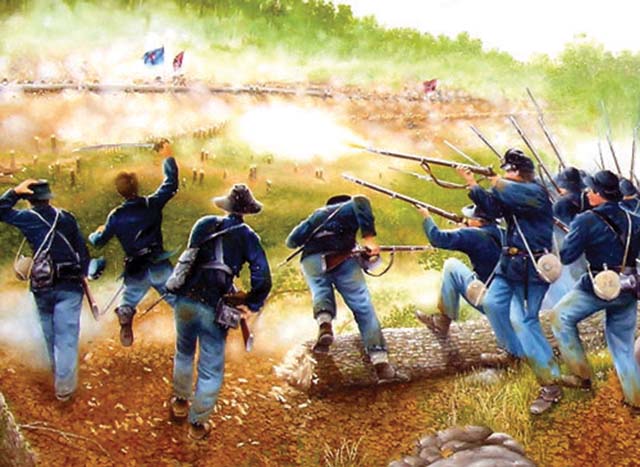
Then: “Called into battle at noon by a drunken officer who we always loved when not drunk. He led us right into works the shape of a horseshoe so that the enemy fired from three ways on us.” A man next to him fell dead and Little thought, “A thousand shall fall at thy side and ten at thy right hand but it shall not come nigh thee” but “the boys said I [was] down at the next volley but only laid about half an hour and up and dumped a big [blood] clot from my hat and raised my gun to fire when a comrade said his gun would not shoot so traded guns and sent me to the rear.”
The Battle of Utoy Creek took place Aug. 5-7, 1864, in Fulton County, Georgia, and ended with a Confederate victory with an estimated 850 casualties and losses on the Union side and 35 for the Confederacy.
Little said he spent four months in the hospital and then joined the regiment at Pulaski, Tennessee. At the end of his letter, Little wrote: “Received three trains of prisoners at Wilmington NC. The worst sight of my life. Love to everybody. Father and Grandfather.”
A Civil War exhibit will be at the Northfield Historical Society from August to November this year and you will be able to see Little’s hat and letter to his grandson on display at that time.

Of course, there is a permanent exhibit at the museum devoted to the 1876 bank raid. On display are photos of James-Younger Gang members taken by Northfield photographer Ira E. Sumner. Sumner’s most famous photos are the ones taken of the propped-up bodies of Clell Miller and Bill Chadwell, the two outlaws killed by valiant Northfielders during the First National Bank robbery attempt. Pictures were taken as a matter of course for identification purposes (the gang did not announce themselves as the James-Younger Gang during the raid) and the enterprising Sumner sold more than 50,000 photos at $2 a dozen of the shirtless duo, eyes open, blood dripping from their fatal wounds.
Scriven told me about how NHS came to have a set of Sumner’s glass plate negatives showing Miller, Chadwell and the outlaws captured or killed at Hanska Slough near Madelia a couple weeks after the raid. Ira Sumner’s son, Stuart (who was also a photographer), owed money to Elmer Nystuen, Phillips 66 Gas Station owner in Northfield, and gave Nystuen the 12 negatives in lieu of payment. Nystuen passed them along to his son, Benjamin. Benjamin then donated them to the Northfield Historical Society in 2007 when he came from Colorado for his 50th St. Olaf College reunion.
“That is why I am 100 percent certain this is a Sumner,” said Scriven of a photo he was showing me, noting that photos of the gang had been taken by other photographers, as well.
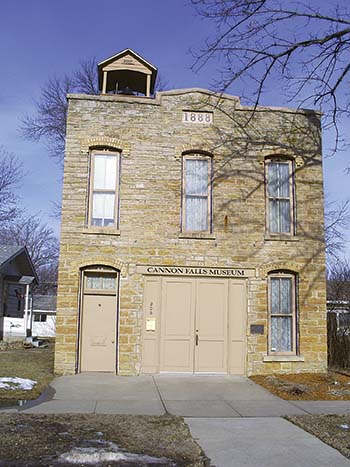
I asked Scriven if the historical society ever gets negative feedback from displaying these graphic images, including offering them in postcard form. He said, “It’s history and it sells. Not that many people get offended by it necessarily. It’s more of, ‘Oh, that’s kind of weird.’ You can’t get any more unique than a picture of some dead robbers. People found it interesting back then and we still do today.”
Scriven is a Nerstrand native who became exhibits coordinator at the historical society after graduation from the University of Minnesota-Duluth in 2005 and was named executive director the next year. He is chairman of this year’s Defeat of Jesse James Days, Sept. 4-8, the largest all-volunteer festival in Minnesota. This year’s motorcycle event, Outlaw Run, will be held on Aug. 10 and Cemetery Stories on Oct. 19. A fund-raiser called “Hops, Grapes and History,” featuring a beer and wine tasting event and Bob Wootton (who was guitarist with Johnny Cash) with Six Mile Grove will be held March 2 at the Grand. For further information about NHS holdings and activities, see northfieldhistory.org and Northfield Historical Society on Facebook.
The Northfield Historical Society was formed in 1976 and established a museum in the Scriver Building at the site where the thwarted bank robbery occurred, 408 S. Division St.

 During a visit to the museum of the Cannon Falls Area Historical Society, my eyes were drawn to a striking display of red leather buckets, which seemed almost like objects of art to me. Such buckets were put to use fighting two terrible fires that raged through Cannon Falls in 1884 and 1887. Pictures at the museum showed the charred ruins left behind and a stunned gathering of citizens observing the devastation. Zachary Wareham, the director of the museum, later provided me with the May 27, 1887, Cannon Falls Beacon account of the May 20 fire. The headlines said it all:
During a visit to the museum of the Cannon Falls Area Historical Society, my eyes were drawn to a striking display of red leather buckets, which seemed almost like objects of art to me. Such buckets were put to use fighting two terrible fires that raged through Cannon Falls in 1884 and 1887. Pictures at the museum showed the charred ruins left behind and a stunned gathering of citizens observing the devastation. Zachary Wareham, the director of the museum, later provided me with the May 27, 1887, Cannon Falls Beacon account of the May 20 fire. The headlines said it all:
“REDUCED TO ASHES. Cannon Falls Visited by a Disasterous Conflagration. Twenty-Seven Business Houses in Ruins. Two-Thirds of the Business Part of Village Gone.”
The story described how the fire bell had “aroused our quiet village” at 10:30 p.m. Seven buildings were on fire within the first 20-30 minutes, then flames swept across the street to engulf many others: “Everywhere that it seemed possible to check the rolling torrent of fire men worked with blistering hands and faces, and only retired to another point when all hope was lost.” Within an hour and a half, most of Cannon Falls businesses – hardware, dry goods and furniture stores, saloons, harness, blacksmith and shoe shops, a hotel, bank, warehouse and the like – were “a smouldering heap of ruins, and $125,000 worth of property was a smoking heap of debris.” The paper said Northfield “responded promptly” to a wire for help, which perhaps “saved further conflagrations” and added, “We must not forget a word of praise for our ladies who exceeded if possible the men in carrying goods from the burning buildings, carrying water, and everywhere proving themselves heroines and braved the perils of the night with the most unflinching courage and fortitude.”

The paper lamented that a town “of this size and enterprise” lacked the organization and apparatus “to retard the march of the fire fiend,” which would perhaps have confined the fire to the first seven wooden buildings. “And now after the first shock and gloom has passed away, hope on silvery wings is coming to our rescue and we hope to see many substantial blocks go up this summer.”
The next year, 1888, the city constructed the Italianate Firemen’s Hall which served as the fire station until 1946. It was the city library from 1953 to 1977 and in 1979 the Cannon Falls Area Historical Society was formed to use this building as a museum under sponsorship of a woman’s group called the Tuesday Club.
The building is on the National Register of Historic Places as one of the oldest (if not the oldest) surviving fire halls in the state. It is not surprising that firefighting equipment is part of the collection here. Wareham said buckets were certainly used to fight both fires and probably would have been organized in old-fashioned bucket brigades, “which worked in two lines of able-bodied people. Buckets would be filled by a person at the water source and then continuously passed up the line towards the fire, then the empty buckets returned to the water source in the other line.” The first fire department in Cannon Falls, organized in 1874, had purchased a hook and ladder truck for $600. Wareham assumes the apparatus may have been stored in a downtown building which burned in the fire.
Also at the museum I took note of pictures of President Calvin Coolidge visiting Cannon Falls on July 29, 1928. I knew that President Barack Obama had a town hall gathering at Lower Hannah’s Bend Park in Cannon Falls on Aug. 15, 2011. But what was our 30th president doing in town 85 years ago? (The taciturn president was known as “Silent Cal” for his lack of loquacity. A famous story is of a young woman sitting next to him at a dinner party who told him she had made a bet she could get three words out of him. He replied, “You lose.”)
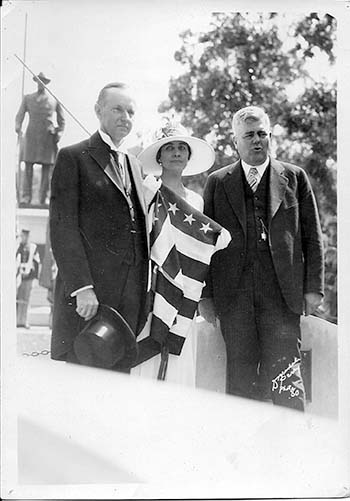
Coolidge was in town to dedicate a memorial in the Cannon Falls Cemetery to the most revered name in town history: William J. Colvill, Jr., a famed Union colonel in the Civil War. It may seem strange but, although Colvill was buried in Cannon Falls, he actually never lived in Cannon Falls. Colvill was a native of New York who in 1854 migrated as a young man to Minnesota, opening a law office in Red Wing and starting a newspaper there. When the Civil War broke out, Colvill became the first man from Goodhue County to volunteer (at age 31) and became captain of Company F, 1st Minnesota Regiment.
Coolidge paid tribute to Colvill and the Minnesota volunteers before more than 25,000 onlookers that day. He said, “Heroic deeds have about them an element of immortality. We stand in reverence before those who perform them and cherish their memory down through the ages.” Coolidge noted: “When Pres. Lincoln called for volunteers to prevent dissolution of the Union, this was the first regiment offered. It gave valiant service upon many a resolutely contested field, but its most conspicuous record was made at Gettysburg on the second day of that decisive battle.” As the Confederates moved forward on July 2, 1863, “The gallant First Minnesota led by Colonel Colvill at once responded with an impetuosity that broke the first and second line of the enemy and stopped the advance. When the action was over but 47 men of the 262 who began the charge were still in line. The remaining 215 lay dead or wounded on the field…By holding the Confederate forces in check until other reserves came up, it probably saved the Union Army from defeat…The whole of the North would have been open to invasion, and perhaps the Union cause would have been lost.” Coolidge said that First Minnesota members “are entitled to rank as the saviors of their country.”
Colvill went on to serve as Minnesota attorney general and in the Minnesota state legislature. He died on June 13,1905, while attending a reunion in Minneapolis of veterans of the First Minnesota, and was buried in the Cannon Falls Community Cemetery next to his wife, Jane Elizabeth (Morgan) Colvill, who had died in 1894.
Colvill’s siblings had followed him to Minnesota and had connections to Cannon Falls. In a Cannon Falls Beacon article of July 28, 1994, Kathy Ericson wrote that Colvill’s sister, Elizabeth, and husband, William Tanner, settled near Cannon Falls and are considered founders of the Episcopal Church. Their son, William, was executor of the estate of Colvill’s wife and president of the local cemetery association, which may explain their burial in Cannon Falls. There is a replica of his gravesite statue in the Minnesota State Capitol, Red Wing has a Colvill Park and a section of Minnesota State Highway 19 from Gaylord to Red Wing was named in his honor in 1931.
Wareham is a native of Cannon Falls with a BA from St. Stephen’s University in New Brunswick and an MA in history at the University of New Brunswick. He returned to Cannon Falls in 2007, began volunteering at the Cannon Falls Museum and was hired as museum director in March of 2011. Wareham also teaches gymnastics to boys and girls at the Northfield Gymnastics Club and is the Boys’ Team coach.
Wareham has worked to improve the website which is now at sites.google.com/site/cannonfallsmuseum and is using Facebook as “Cannon Falls Area Historical Museum” to communicate online. He is in the process of cataloguing the collections, which include such things as residents’ military service records, a Swedish farmer’s daily journal covering the years 1869-1903, numerous photos, books, newspapers and the like. Many temporary displays have been put up to showcase holdings and a traveling exhibit on Stanton Airfield was set up for the Northfield Historical Society, was viewed in Cannon Falls and now is permanently on display in Stanton.
Wareham told me his favorite part of the job is “meeting people and listening to their stories, sharing our history and helping patrons with research.” One challenge the museum has is the issue of storage, which will be alleviated temporarily when the library moves out of the city hall and some collections can be stored there. The museum was helped recently by a donation of shelving from the Northfield Historical Society, after NHS had received a grant to replace the shelves they had. Wareham said he is excited about an upcoming renovation project “so that we can care for our collections better and share our history,” a process that will be aided by off-site storage.
The Cannon Falls Museum of the Cannon Falls Area Historical Society is located at 206 West Mill St.
The genesis of the Dundas Historical Society was a tour of the Mill City Museum in Minneapolis, taken by Dundas residents Michelle Millenacker and Glenn Switzer in 2003. The couple was impressed by the museum, which was built into the ruins of what was once the world’s largest flour mill. Millenacker told me that they noticed there was “no reference in particular” to the milling history of the Dundas-Northfield area. And Millenacker got to thinking about the ruins of the Archibald Mill in Dundas and speculated that “if that mill is not somehow preserved, it will disappear in my lifetime.” Then Switzer (who is the current mayor of Dundas and owner of Switzer’s Nursery and Landscaping business) looked at her and said, “So what are you going to do about it?”

Millenacker, a history buff who has a psychology practice in Northfield, was daunted at first at the idea of starting a historical organization (“like having a whole other job that you’re doing for free”). But in 2005 the all-volunteer Dundas Historical Society was formed as a legal non-profit by a small group of interested people with Millenacker as its president.
On June 22-24, 2007, Dundas had a community celebration for its Sesquicentennial (150th anniversary). The society set up a “one day museum” at City Hall with items of historic interest donated or loaned by citizens.
“We thought it was sort of a one-shot deal,” said Millenacker, but then people would ask, “What is next year going to be like?” Now “Celebrate Dundas” is becoming an annual event. This year’s dates are June 28-29, beginning with a Dundas Dukes baseball game on Friday. A popular event is a baseball clinic for the kids held with the Dukes. The society is soliciting photographs of former Dundas businesses to be scanned and put on display for the one-day museum.
Dundas had a population of 547 in 2000 and now has about 1,400 residents, so the society has hopes for future growth. A long-term goal of the Dundas Historical Society is to have a museum which lasts more than a day, where the society can collect and display artifacts. Currently, society members safeguard Dundas memorabilia in their homes and some is stored at the police station. Frandsen Bank at 715 Stafford Road North has a rotating display case on historic themes and Arlene Williams told me the next one will be springtime Dundas community sports, including the Dundas Dukes.
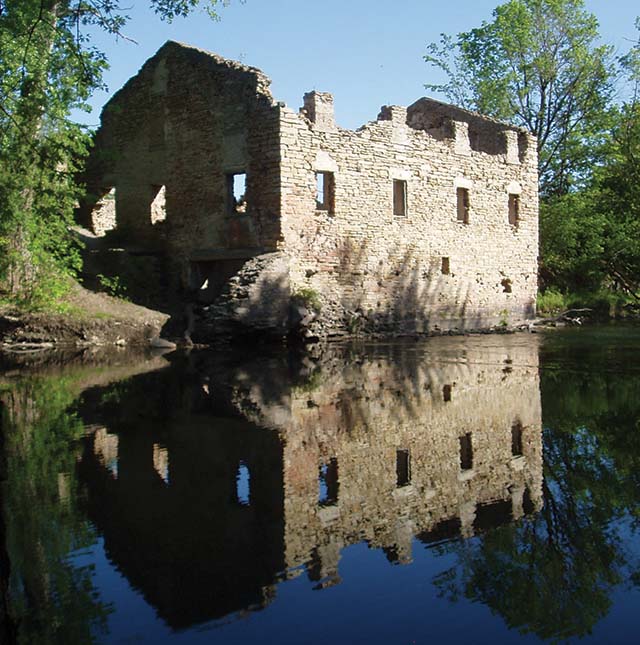
Millenacker would also like to see that whatever museum may be established can be used by Dundas residents as a gathering spot for the town. The historic Archibald Mill, which inspired formation of the society has been purchased by the City of Dundas and, said Millenacker, “We hope to work with them regarding preservation.”
Dave Machacek of ArtOrg (a Northfield arts organization, which is now relocating to Cannon Falls) was among those looking through the photographs at City Hall in 2007. Millenacker said, “He got this idea to do a Twenty Views of Dundas commemorative album. We thought it would be phenomenal.” As described on the ArtOrg website, the 2008 collaborative print project engaged 20 artists to interpret Dundas history in a work of art and, working together with an art printer, they “created hand-pulled sets of prints in a very limited edition size.” About one-third of the artists came from Dundas, another third from Northfield and the rest from the Twin Cities and a couple other locations. The artists had access to old photographs online and many met with residents and visited town sites for inspiration.
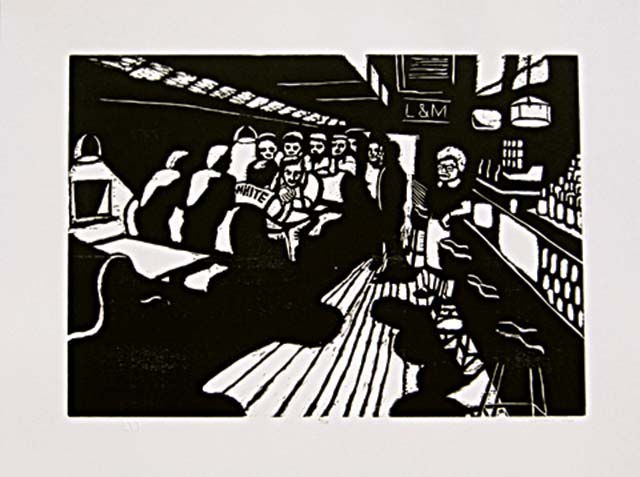 The resulting art work was of such high quality that a set was accessioned into the permanent collection at the Frederick R. Weisman Art Museum at the University of Minnesota. Participating artists were Kari Alberg, James Boyd Brent, David Burt, Hope Cook, Mac Gimse, Alexander Hage, Fred Hagstrom, Marty Harris, Ray Jacobson, Lilla Johnson, Scott King, Sharol Nau with Pat Lampe, Meg Ojala, Gaylord Schanilec, Diane Schrader, Carol Van Sickle, Fred Somers, Carolyn Swiszcz, Xavier Tavera and Scott West.
The resulting art work was of such high quality that a set was accessioned into the permanent collection at the Frederick R. Weisman Art Museum at the University of Minnesota. Participating artists were Kari Alberg, James Boyd Brent, David Burt, Hope Cook, Mac Gimse, Alexander Hage, Fred Hagstrom, Marty Harris, Ray Jacobson, Lilla Johnson, Scott King, Sharol Nau with Pat Lampe, Meg Ojala, Gaylord Schanilec, Diane Schrader, Carol Van Sickle, Fred Somers, Carolyn Swiszcz, Xavier Tavera and Scott West.


